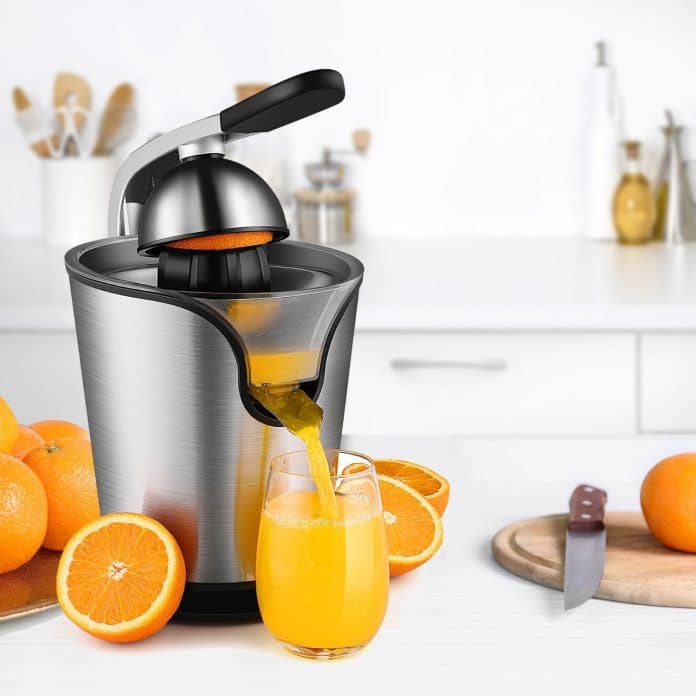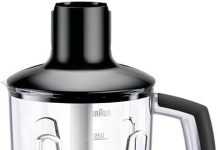Are you a fan of fresh orange juice but tired of discarding all those nutritious peels? Well, you’ll be pleased to know that with a masticating juicer, you can now enjoy orange juice with the peels intact! Masticating juicers, also known as slow juicers, are known for their ability to extract juice from a variety of fruits, including oranges with peels. Not only does this save time and effort, but it also retains more nutrients and fiber compared to traditional juicers. So go ahead and embrace the full potential of your masticating juicer by juicing oranges with peels – a delightful and healthy twist on your morning routine!
Review contents
What is a masticating juicer?
A masticating juicer, also known as a cold press juicer or a slow juicer, is a type of juicer that operates at a slower speed compared to other juicers such as centrifugal juicers. This slower speed helps preserve the quality and nutritional value of the juice by minimizing oxidation and heat generation. The masticating juicer uses a single auger or gear to slowly crush and squeeze the fruits and vegetables, extracting the juice from the pulp.
How does a masticating juicer work?
A masticating juicer works by first feeding the fruits or vegetables into the chute. The auger or gear then slowly rotates and crushes the produce against a pulp screen, separating the juice from the pulp. The juice is collected in one container, while the pulp is expelled into a separate container. This method of juicing helps retain more nutrients and enzymes compared to other juicers, as the slow speed prevents excessive heat and oxidation from damaging the juice.
This image is property of i.ytimg.com.
Benefits of using a masticating juicer
Using a masticating juicer offers several benefits. Firstly, the slow and gentle juicing process helps retain more nutrients, vitamins, and enzymes, resulting in a higher quality juice. This makes masticating juicers a popular choice for those seeking to maximize their intake of essential nutrients. Additionally, the slow juicing process also produces less foam and heat, which can further ensure the preservation of the juice’s nutritional value.
Furthermore, masticating juicers are versatile and can handle a wide variety of fruits, vegetables, leafy greens, and even wheatgrass. This flexibility allows you to experiment with different combinations and flavors to create delicious and nutritious juice blends. Lastly, masticating juicers are generally quieter in operation compared to centrifugal juicers, making them a great choice for those who value a peaceful and noise-free juicing experience.
Can you juice oranges with peels?
Yes, you can juice oranges with peels using a masticating juicer. Masticating juicers are designed to efficiently extract juice from a variety of fruits, including oranges. The slow and thorough juicing process of a masticating juicer ensures that the orange peels are properly processed and incorporated into the juice, resulting in a smooth, flavorful, and nutrient-packed beverage.
This image is property of img.livestrong.com.
Pros of juicing oranges with peels
Juicing oranges with peels offers several advantages. Firstly, it allows you to reap the maximum nutritional benefits of the fruit. Orange peels contain a significant amount of nutrients, including dietary fiber, vitamins, minerals, and antioxidants. By including the peels in the juice, you can enhance its nutritional profile, making it even more beneficial for your health.
Additionally, juicing oranges with peels reduces food waste. Many people discard the peels when juicing oranges, which results in unnecessary waste. By utilizing the entire fruit, including the peels, you contribute to a more sustainable approach to juicing and minimize the environmental impact of your juicing habits.
Preparation
Washing the oranges
Before juicing oranges with peels, it is essential to thoroughly wash the fruit. Rinse the oranges under cool running water and gently scrub the outer surface with a vegetable brush. This helps remove any dirt, debris, or surface pesticides present on the peels. By washing the oranges, you ensure that your juice is clean and free from any contaminants.
Peeling or not peeling the oranges
When it comes to juicing oranges with peels, the decision to peel or not to peel is entirely up to personal preference. The peels are edible and can be consumed without causing any harm. However, some individuals may find the taste or texture of the peels unpleasant, and therefore prefer to remove them prior to juicing. If you choose to juice with the peels, make sure to use organic oranges for added peace of mind.
Cutting the oranges into smaller pieces
To ensure smooth and efficient juicing, it is recommended to cut the oranges into smaller, manageable pieces before feeding them into the masticating juicer. This helps prevent clogging and allows the juicer’s auger or gear to effectively process the oranges and extract the juice. Cutting the oranges into quarters or eighths is typically sufficient, but you can adjust the size according to the specifications of your juicer.
This image is property of i.ytimg.com.
Operating the masticating juicer
Assembling the juicer
Before you begin juicing, make sure to properly assemble your masticating juicer according to the manufacturer’s instructions. This typically involves attaching the auger or gear, pulp screen, juice container, and pulp container. Ensuring that all components are securely in place is essential for safe and efficient juicing.
Feeding the oranges into the juicer
Once the juicer is assembled, it’s time to start juicing the oranges with peels. Take a piece of the prepared orange and gently feed it into the chute of the juicer. Use the pusher or tamper provided with your juicer to push the orange down, ensuring a steady and consistent feeding rate. Continue adding more orange pieces into the juicer until you have processed all the oranges.
Collecting the juice
As the oranges are being juiced, the masticating juicer will separate the juice from the pulp. The juice will flow out through the designated spout or outlet and into the juice container. Make sure to place the container in the appropriate position to catch the juice. Monitor the container and be prepared to empty it if needed as you continue juicing.
Cleaning the juicer
After juicing is complete, it is important to clean the juicer thoroughly to maintain its performance and longevity. Disassemble the juicer and rinse all the components under warm water to remove any remaining pulp or juice. Use a brush or sponge to scrub away any stubborn residue. Refer to the manufacturer’s instructions for specific cleaning guidelines. Once cleaned, allow the juicer parts to dry completely before reassembling or storing.
Juice quality and taste
Does juicing oranges with peels affect the taste?
Juicing oranges with peels can have a noticeable impact on the taste of the juice. The orange peels contain natural oils that can add a slightly bitter or tangy flavor to the juice. While some people enjoy this added complexity, others may find it less desirable. However, the overall taste will depend on factors such as the variety and ripeness of the oranges, as well as personal preference. It is recommended to try juicing oranges with peels and adjust the quantities according to your taste preferences.
Does the juice contain more nutrients?
By including the orange peels, juicing oranges results in a juice that is richer in nutrients compared to juice made without peels. Orange peels contain higher levels of dietary fiber, vitamins A and C, and essential minerals like potassium and calcium. These nutrients are beneficial for overall health, supporting digestion, immune function, and skin health. Juicing with peels allows you to maximize the nutritional potential of your orange juice.
Possible bitter taste of the juice
As mentioned earlier, the orange peels can contribute a slightly bitter taste to the juice. This bitterness is caused by the presence of natural compounds, such as flavonoids, that are more concentrated in the peels. While some individuals may find the bitterness unappealing, others may enjoy the added complexity it brings to the flavor profile. If you find the juice too bitter, consider adjusting the amount of peels used, or combine the oranges with sweeter fruits or vegetables to balance the taste.
This image is property of storables.com.
Benefits of juicing oranges with peels
Reduced waste
Juicing oranges with peels helps reduce food waste by utilizing the entire fruit. Instead of discarding the peels, which is commonly done when juicing oranges, you maximize the use of the fruit and contribute to a more sustainable approach to juicing.
Increased nutrient intake
Including the orange peels in your juice boosts its nutritional value. The peels are a good source of dietary fiber, vitamins, minerals, and antioxidants. By juicing oranges with peels, you can increase your intake of these beneficial compounds and support overall health and wellbeing.
Boost in fiber content
Dietary fiber is essential for digestive health and promoting feelings of fullness. By juicing oranges with peels, you increase the fiber content of the juice, enhancing its ability to support healthy digestion and contribute to a balanced diet.
Potential drawbacks
Pesticide residue on the peels
When juicing oranges, it is important to consider the potential presence of pesticide residue on the peels. Non-organic oranges may have been treated with pesticides, which can cling to the outer surface of the fruit. Washing the oranges thoroughly before juicing can help remove some of the pesticide residue, but opting for organic oranges is a safer choice if you are concerned about pesticide exposure.
Bitter taste
The inclusion of orange peels in the juice can introduce a bitter taste. While some individuals enjoy this added complexity, others may find it less appealing. Adjusting the amount of peels used or combining the oranges with sweeter fruits or vegetables can help balance the taste if the bitterness is too strong.
Digestive issues
For some individuals, consuming orange peels may cause digestive discomfort. The peels contain a compound called limonene, which can irritate the digestive system in some people. If you experience any adverse digestive effects after juicing oranges with peels, it is best to discontinue their use and consult with a healthcare professional.
This image is property of img.livestrong.com.
Variations and alternatives
Using organic oranges
To minimize the potential risks associated with pesticide residue, consider using organic oranges when juicing with peels. Organic oranges are grown without the use of synthetic pesticides, reducing the likelihood of pesticide residues on the peels.
Blending oranges with peels
If you prefer a smoother texture and minimizing the bitter taste, an alternative approach is to blend the oranges with peels instead of juicing. By blending, you incorporate the entire fruit, including the peels, resulting in a thicker and more fiber-rich beverage. This method allows you to enjoy the benefits of the peels while minimizing any bitterness.
Straining the juice
If you find the taste of the juice too bitter or prefer a smoother texture, you can strain the juice after juicing oranges with peels. Using a fine mesh strainer or cheesecloth, strain the juice to remove any larger particles or remnants of the peels. This will result in a smoother and more refined juice, while still retaining the nutritional benefits of the peels.
Tips for juicing oranges with peels
Choosing ripe and fresh oranges
When juicing oranges with peels, select oranges that are ripe and fresh. Ripe oranges tend to be sweeter and have a more balanced flavor profile. Look for oranges that feel heavy for their size and have a vibrant color. Avoid using oranges that are overly soft, moldy, or have an unpleasant odor.
Mixing with other fruits or vegetables
To modify the taste and balance the flavor of the juice, consider mixing the oranges with other fruits or vegetables. Experiment with different combinations, such as adding apples, carrots, or ginger, to create unique and flavorful juice blends. The addition of other ingredients can help offset any bitterness from the orange peels and create a more enjoyable juicing experience.
Experimenting with different peel amounts
If you are unsure about how much peel to include, start by juicing a small amount of peel and gradually increase it according to your taste preferences. This allows you to find the right balance that suits your palate. Keep in mind that different oranges may have varying peel thickness and bitterness levels, so adjustments may be necessary with each batch of oranges.
Conclusion
Juicing oranges with peels using a masticating juicer is not only possible but also offers numerous benefits. By utilizing the entire fruit, you reduce waste, increase your intake of vital nutrients, and boost the fiber content of your juice. While the taste may be slightly bitter due to the presence of orange peels, this can be balanced by adjusting the amount of peels used or blending the oranges for a smoother texture. Just be mindful of pesticide residue and any potential digestive issues that may arise. With proper preparation, operation, and a few helpful tips, juicing oranges with peels can be a delicious and healthy addition to your juicing routine. So grab some fresh oranges, fire up your masticating juicer, and enjoy the vibrant and nutritious goodness of orange juice with peels!




































